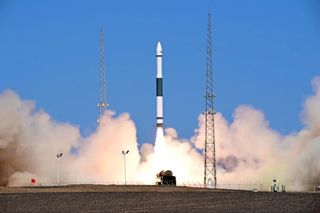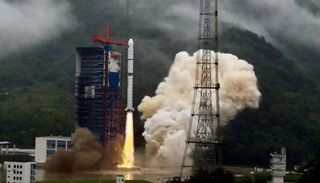China launches 4 satellites with 2 rockets in 2 days
A Chinese solid rocket returned to flight, and another booster sent spy satellites to orbit.

China is continuing its quest to carry out more than 50 orbital launches this year with a pair of missions lifting off within just over 24 hours of each other.
Commercial launch service provider Expace launched a Kuaizhou-1A rocket from Jiuquan Satellite Launch Center in the Gobi Desert in northwest China using a transport erector launcher (TEL) at 10:08 p.m. EDT on June 21 (0208 GMT; 10:08 a.m. Beijing time, June 22).
The light-lift solid rocket sent the Tianxing 1 satellite into a near polar orbit, but with a relatively low perigee and apogee (nearest and farthest points from Earth in its orbit) of 173 miles and 181 miles (278 and 291 kilometers), respectively.
Related: The latest news about China's space program

Little is known about Tianxing 1 and whether or not it can substantially raise its own orbit. The satellite was developed by the Institute of Mechanics under the Chinese Academy of Sciences (CAS), according to SpaceNews, and was described vaguely by Chinese media as to be used for "space environment detection."
The launch was the first flight of the Kuaizhou-1A since a failure in December 2021. Expace is a subsidiary of the China Aerospace Science and Industry Corporation (CASIC), a state-owned defense giant with its own commercial space plans.
CASIC is a sister company to the China Aerospace Science and Technology Corporation (CASC), which is the country's main space contractor and operator of the Long March rocket families.
Get the Space.com Newsletter
Breaking space news, the latest updates on rocket launches, skywatching events and more!
CASC carried out its own launch a little over 24 hours later, with a Long March 2D rocket lifting off from Xichang Satellite Launch Center in the southwest of the country at 10:22 p.m. EDT on June 22 (0222 GMT and 10:22 a.m. Beijing time on June 23).
Three Yaogan 35 (02 group) satellites were sent into orbits with an average altitude of roughly 310 miles (500 km) with an inclination of 35 degrees. The first batch of Yaogan 35 satellites were launched in November 2021.
Chinese state media outlet Xinhua reported that the trio of sats would be mainly used to "conduct science experiments, land resource surveys, yield estimation of agricultural products and disaster prevention and reduction."
Outside of China, it is believed that Yaogan satellites are for military purposes, similar to how Russia and the U.S. use "Kosmos" and "USA" designations, respectively, for military satellites.
The launches were China's 21st and 22nd of the year. CASC alone plans more than 50 missions across 2022, including six missions to complete the country's Tiangong space station.
Follow us on Twitter @Spacedotcom or on Facebook.
Join our Space Forums to keep talking space on the latest missions, night sky and more! And if you have a news tip, correction or comment, let us know at: community@space.com.

Andrew is a freelance space journalist with a focus on reporting on China's rapidly growing space sector. He began writing for Space.com in 2019 and writes for SpaceNews, IEEE Spectrum, National Geographic, Sky & Telescope, New Scientist and others. Andrew first caught the space bug when, as a youngster, he saw Voyager images of other worlds in our solar system for the first time. Away from space, Andrew enjoys trail running in the forests of Finland. You can follow him on Twitter @AJ_FI.
